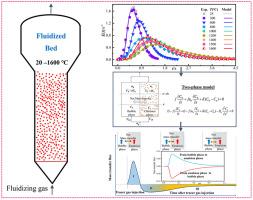Characteristics of mass transfer between bubble and emulsion phases of high-temperature gas–solid bubbling fluidized beds
IF 4.3
2区 材料科学
Q2 ENGINEERING, CHEMICAL
引用次数: 0
Abstract
Understanding interphase mass transfer is crucial for the efficient design and operation of gas–solid fluidized beds, which are widely used in various industrial processes. However, research on mass transfer behavior in such systems, particularly at high temperatures (e.g., >1000 °C), remains sparse. This study, dedicated to Profs. Yong Jin and Zhiqing Yu's contributions to fluidization, elucidates the mass transfer behavior of gas-solid bubbling fluidized beds at temperatures up to 1600 °C by modeling gas residence time distribution data using a two-phase model. We examine the effects of temperature, gas velocity, bed height, and particle size on mass transfer characteristics. The results reveal that the mass transfer flux increases with temperature up to 800 °C, peaking within this range before stabilizing above 1200 °C. This trend is closely linked to the behavior of bubble dynamics, where bubble size initially decreases significantly as temperature rises, eventually reaching a plateau at higher temperatures. Experimental pressure fluctuation analysis validates this behavior, further supporting the observed temperature effects on bubble dynamics. Higher gas velocity reduces the mass transfer flux and mitigates back-mixing, while bed height and particle size affect bubble dynamics in a nonlinear manner. Experimental validation confirms the potential of these findings for optimizing the design and operation of high-temperature bubbling fluidized bed reactors.

高温气固鼓泡流化床泡相与乳相传质特性
气固流化床广泛应用于各种工业生产过程,了解气固流化床的传质特性对其高效设计和运行至关重要。然而,对这种系统的传质行为的研究,特别是在高温下(例如,1000°C),仍然很少。这项研究,献给教授们。金勇和余志清对流态化的贡献,通过使用两相模型模拟气体停留时间分布数据,阐明了温度高达1600°C时气固鼓泡流化床的传质行为。我们研究了温度、气速、床层高度和粒径对传质特性的影响。结果表明,在温度高达800℃时,传质通量随温度升高而增大,在此范围内达到峰值,在1200℃以上趋于稳定。这一趋势与气泡动力学行为密切相关,气泡尺寸最初随着温度升高而显著减小,最终在更高温度下达到平稳期。实验压力波动分析验证了这一行为,进一步支持了观察到的温度对气泡动力学的影响。较高的气速降低了传质通量,减轻了反混合,而床层高度和粒径以非线性方式影响气泡动力学。实验验证证实了这些发现在优化高温鼓泡流化床反应器的设计和运行方面的潜力。
本文章由计算机程序翻译,如有差异,请以英文原文为准。
求助全文
约1分钟内获得全文
求助全文
来源期刊

Particuology
工程技术-材料科学:综合
CiteScore
6.70
自引率
2.90%
发文量
1730
审稿时长
32 days
期刊介绍:
The word ‘particuology’ was coined to parallel the discipline for the science and technology of particles.
Particuology is an interdisciplinary journal that publishes frontier research articles and critical reviews on the discovery, formulation and engineering of particulate materials, processes and systems. It especially welcomes contributions utilising advanced theoretical, modelling and measurement methods to enable the discovery and creation of new particulate materials, and the manufacturing of functional particulate-based products, such as sensors.
Papers are handled by Thematic Editors who oversee contributions from specific subject fields. These fields are classified into: Particle Synthesis and Modification; Particle Characterization and Measurement; Granular Systems and Bulk Solids Technology; Fluidization and Particle-Fluid Systems; Aerosols; and Applications of Particle Technology.
Key topics concerning the creation and processing of particulates include:
-Modelling and simulation of particle formation, collective behaviour of particles and systems for particle production over a broad spectrum of length scales
-Mining of experimental data for particle synthesis and surface properties to facilitate the creation of new materials and processes
-Particle design and preparation including controlled response and sensing functionalities in formation, delivery systems and biological systems, etc.
-Experimental and computational methods for visualization and analysis of particulate system.
These topics are broadly relevant to the production of materials, pharmaceuticals and food, and to the conversion of energy resources to fuels and protection of the environment.
 求助内容:
求助内容: 应助结果提醒方式:
应助结果提醒方式:


